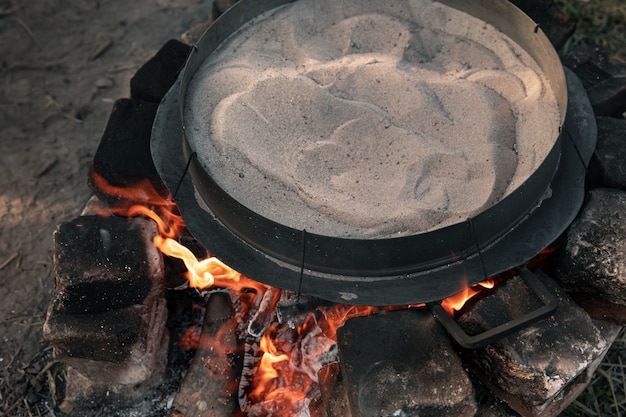Let me tell you, there's nothing quite like the feeling of a perfectly seasoned cast iron skillet in your hands. It's a culinary workhorse, capable of turning out everything from mouthwatering steaks to crusty sourdough bread. But as much as I love my cast iron, I've learned that not all foods are created equal when it comes to this beloved cookware. (Part 1)
The Delicate Balance of Cast Iron Seasoning

Think of the seasoning on your cast iron like a protective shield. It's that slick, black layer that keeps your food from sticking and gives your cast iron its iconic nonstick properties. But this shield is delicate, and certain foods can weaken or even destroy it, leading to a sticky mess and a less-than-ideal cooking experience.
Acid: The Enemy of Cast Iron Seasoning
The biggest villain in the cast iron world? Acid. Citrus juices, tomatoes, vinegar, wine – they're all acid-packed culprits that can strip away your seasoning, leaving your pan susceptible to rust and turning your once-smooth cooking surface into a sticky nightmare.
I've learned this the hard way. One time, I tried to make a lemon-dill sauce in my cast iron pan, and it was a complete disaster. The sauce etched away the seasoning, leaving my pan with a dull, rusty appearance. It took me ages to restore it to its former glory!
Salt: The Subtle Saboteur
Now, you might think salt is a cast iron's friend, and generally, it is. But, let's be real, we've all been there – leaving a pile of salt to crystallize on the pan, creating those stubborn white patches that seem impossible to remove. These patches can actually damage the seasoning over time.
Sticky Foods: The Cast Iron's Nemesis
Beyond acid, there are certain foods that are simply too prone to sticking to cast iron, even with a well-seasoned surface. Imagine trying to cook delicate fish or scrambled eggs in your trusty cast iron – you'd end up with a mess, and your pan would be a nightmare to clean.
The Foods to Avoid (And Why)

Let's get specific. Here are some of the foods that are best avoided when cooking with cast iron:
1. Citrus Fruits: The Acidic Attack
Lemons, limes, oranges – they're all full of that dreaded acid, and they'll leave your cast iron looking dull and rusty. I've learned to steer clear of cooking anything with citrus juice in my cast iron. A stainless steel pan or non-stick skillet is a much better choice.
2. Tomatoes: The Red Menace
Tomatoes are another acid-packed villain. They can react with the seasoning, giving your pan a dull appearance and a rough texture. For tomato-based sauces and chili, I recommend using a different pan.
3. Vinegar: The Sour Saboteur
Vinegar is a staple in many kitchens, but it's not a good friend of cast iron. That acidic bite can react with the seasoning and cause it to flake off, making your pan less effective and more susceptible to rust.
4. Wine: The Alcoholic Antagonist
Wine, with its natural acidity, can also damage your cast iron's seasoning. If you're using wine in a recipe, consider using a different pan, or at least deglaze it carefully to avoid leaving behind any acidic residue.
5. Sticky Foods: The Cast Iron's Bane
Foods that tend to stick to the pan are a recipe for disaster when it comes to cast iron. Here are some of the stickiest offenders:
(Part 2)
6. Eggs: The Scrambled Scourge
Scrambled eggs and omelets are notorious for sticking to cast iron, even when well-seasoned. They're much happier in a non-stick skillet. I used to think I could conquer this challenge, but after numerous failed attempts, I've learned to embrace non-stick for my egg dishes.
7. Delicate Fish: The Fragile Foe
Fish fillets are so delicate, they're prone to sticking and tearing in a cast iron pan. While a well-seasoned cast iron can handle some fish, I find it's safer to use a non-stick pan for these slippery creatures.
8. Creamy Sauces: The Thick and Troublesome
Creamy sauces like Alfredo or carbonara can also create a sticky situation in a cast iron pan. The thick, creamy texture makes them difficult to release from the surface, and cleaning the pan afterwards can be a real chore.
9. Sauces with Sugar: The Sweet and Sticky Disaster
Sweet sauces with added sugar are a big no-no for cast iron. The sugar caramelizes, sticks to the pan, and makes cleaning a nightmare.
cast iron care and Cleaning: A Love Letter to Your Pan

A good cast iron care routine is crucial for keeping your seasoning in top shape and ensuring years of enjoyable cooking.
1. Proper Cleaning: Gentle but Effective
After each use, wash your cast iron skillet with hot water and a little bit of soap. Avoid harsh detergents or abrasive scrubbers, as these can damage the seasoning.
I used to think I could just scrub away any stuck-on food, but I learned the hard way that harsh scrubbing can strip away the seasoning, leaving the pan vulnerable. Gentle is the name of the game!
2. The Importance of Drying: Prevent Rust with Speed
Wipe your pan dry immediately after washing. Moisture is the enemy of cast iron, as it can lead to rust. A quick dry will help prevent this.
3. The Power of Oil: A Protective Layer
Apply a thin layer of oil to the entire surface of your pan after drying. This will help to keep it seasoned and prevent rust. I use a paper towel or a clean cloth for this task.
4. Seasoning Your Cast Iron: A Fresh Start
If your seasoning starts to wear down, don't worry! You can easily re-season your cast iron skillet.
The seasoning process is pretty straightforward. Just apply a thin layer of oil to the pan and heat it in a low oven for a few hours. This will create a new layer of seasoning.
5. When to Re-Season: Signs of a Weakening Shield
You'll know your cast iron needs re-seasoning when it starts to lose its nonstick properties and becomes stickier to use. If you notice the food sticking more often, it's time to give your pan a fresh coat of seasoning.
FAQs: Cast Iron Answers for Every Question
Now, let's address some common questions about cast iron.
1. Can I use cast iron for baking?
Absolutely! cast iron skillets are fantastic for baking bread, pizza, and even cakes. Just remember to preheat the oven to a high temperature before placing the pan inside.
I love using my cast iron for baking sourdough bread. It gives the loaf a beautiful crust and a perfect texture.
2. Can I use cast iron in the oven?
Yes, most cast iron cookware is oven safe. You can use it for baking, roasting, and even braising.
3. Can I use cast iron on the stovetop?
Of course! Cast iron is perfect for stovetop cooking, from searing steaks to sauteing vegetables.
4. Can I use cast iron on the grill?
Yes, but be cautious. Cast iron can get incredibly hot on the grill, so handle it with care. Always use oven mitts and avoid touching the pan directly.
5. Can I use cast iron for frying?
Yes, cast iron is perfect for frying. Just be sure to use a high-heat oil with a high smoke point, like peanut oil or canola oil.
Other Cast Iron Tips: Mastering the Art of Cast Iron
Here are a few more tips to help you get the most out of your cast iron cookware:
1. Avoid Overcrowding: Space for Even Cooking
Don't overcrowd your cast iron skillet. Give your food space to cook evenly.
2. Don't Use Metal Utensils: A Gentle Touch for Seasoning
Metal utensils can scratch the seasoning on your cast iron. Use wooden or silicone utensils instead.
I keep a set of wooden spoons and spatulas specifically for my cast iron to avoid any damage.
3. Preheat Thoroughly: For Even Cooking and a Perfect Crust
Before cooking, preheat your cast iron skillet over medium heat for a few minutes. This will help to create a more even cooking surface and ensure that your food gets a beautiful crust.
4. Don't Wash with Soap Every Time: Sometimes Less is More
After cooking greasy foods, you can often simply wipe the pan clean with a paper towel. Washing with soap isn't always necessary.
For everyday use, I try to avoid washing my cast iron with soap as much as possible.
5. Store Properly: A Safe Haven for Your Cast Iron
Store your cast iron skillet in a dry place. You can hang it on a hook or store it in a drawer lined with a paper towel.
Conclusion: A Cast Iron Journey of Love and Care
There you have it, folks! A comprehensive guide to using cast iron cookware. It's a fantastic piece of equipment, but like any good tool, it requires a bit of understanding and care. By avoiding those acidic culprits and keeping your seasoning in tip-top shape, you'll enjoy years of delicious cooking with your cast iron. And remember, if you have any doubts, it's always best to play it safe and use another pan!
Happy cooking!
Everyone is watching

Prime Rib Roast Cooking Time Chart: Per Pound Guide
Cooking TipsPrime rib roast. Just the name conjures images of lavish dinners, crackling fires, and hearty laughter. It’s ...

How Long to Bake Potatoes in the Oven (Perfect Every Time)
Cooking TipsBaked potatoes are a staple in my kitchen. They're incredibly versatile, delicious, and surprisingly easy to m...

Perfect Rice Every Time: The Ultimate Guide to Cooking Rice
Cooking TipsAs a self-proclaimed foodie, I've always been a bit obsessed with rice. It's the foundation of countless cuisi...

The Ultimate Guide to Cooking Asparagus: Tips, Techniques, and Recipes
Cooking TipsAsparagus. The mere mention of this spring delicacy conjures up images of vibrant green spears, crisp and burs...

Ultimate Guide to Cooking the Perfect Thanksgiving Turkey
Cooking TipsThanksgiving. Just the word conjures up images of overflowing tables laden with delicious food, the scent of r...
